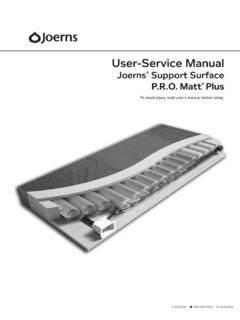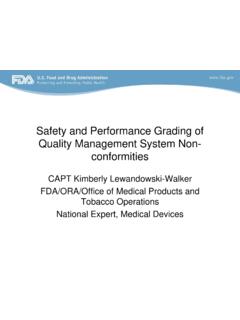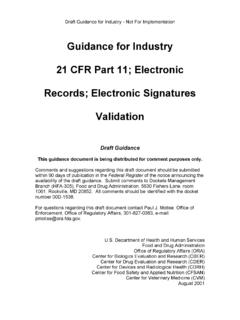Transcription of The use of compound topical anesthetics
1 Author reviewed the history of,federal regulations regarding, risks of and adversedrug reactions of five compound topical anesthetics :tetracaine, adrenaline/epinephrine and cocaine (TAC);lidocaine, adrenaline/epinephrine and tetracaine (LET); lidocaine, tetracaine and phenylephrine (TAC 20 percent Alternate); lidocaine,prilocaine and tetracaine (Profound); and lidocaine, prilocaine, tetracaineand phenylephrine with thickeners (Profound PET).Types of Studies author reviewed clinical trials,case reports, descriptive articles, and Food and drug Administration(FDA) regulations and recent public advisory warnings regarding the fed-eral approval of and risks associated with the use of compound topical anesthetics are neither FDA-regulated nor -unregulated.
2 Some compounding pharmacies bypass the new FDA drugapproval process, which is based on reliable scientific data and ensuresthat a marketed drug is safe, effective, properly manufactured and accu-rately labeled. Two deaths have been attributed to the lay use of com-pound topical anesthetics . In response, the FDA has announced thestrengthening of its efforts against unapproved drug products. Clinical Implications. compound topical anesthetics may be aneffective alternative to local infiltration for some minimally invasivedental procedures; however, legitimate concerns exist in regard to theirsafety.
3 Until they become federally regulated, compound topical anes-thetics remain unapproved drug products whose benefits may not out-weigh their risks for dental Words. topical anesthetics ; Food and drug Administration; 2007;138(10) is the processby which the pharmacistor doctor combines, mixesor alters pharmaceuticalsor ingredients to create acustom-made medication in accor-dance with a compounds in the form ofanti-inflammatories, mouthrinses,toothpastes, antibiotic preparations,soaps, electrolyte troches, bleachinggels and strong topical anestheticsare commonplace in dentistry. Inparticular, compound topical anes-thetics are applied to patients bypediatric dentists for restorativeprocedures, by periodontists forscaling and root planing procedures,by orthodontists for soft-tissue lasersurgery and placement of ortho-dontic temporary anchorage devices(TADs), and by oral surgeons forfacial rejuvenating procedures.
4 In2006, however, several Foodand drug Administration (FDA)advisory reports were issuedregarding the potential hazards ofusing compound topical January 2007, I conducted asearch on PubMed to identify English-language, full-text articlespublished from Jan. 1, 1980,through Dec. 31, 2006. The searchterms I used were topical , anes-thetic, compound , pharmaceu-tical and Food drug Administra-tion. I also searched for relevantABSTRACTARTICLE2Dr. Kravitz was an orthodontic resident, Department of Orthodontics, University of Illinois at ChicagoCollege of Dentistry, when this article was written.
5 He now is in private practice in Chantilly, reprint requests to Dr. Kravitz at 6017 Makely Drive, Fairfax Station, Va. 22039, e-mail .JADACONTINUINGEDUCATION The use of compound topical anestheticsA reviewNeal D. Kravitz, DMD, MSCLINICAL PRACTICECRITICAL REVIEW JADA, Vol. 138 October 20071333 Copyright 2007 American Dental Association. All rights , using the reference lists of already iden-tified this article, I review the history, regula-tions, recent FDA warnings and life-threateningside effects of compound topical anesthetics . Iexamine clinical trials, case reports, descriptivearticles, FDA regulations and recent public advi-sory warnings regarding the federal approval andrisks associated with the use of compound COMPOUNDINGP harmaceutical compounding has been part ofpharmacy practice since its origins.
6 Before syn-thetic and premade pharmaceuticals were avail-able, physicians would write prescriptions thatlocal pharmacists would compound to producecapsules, tablets or suspensions. Industrial drugmanufacturing, however, was able to producedrugs more efficiently and in bulk led to the decline in compounding at localpharmacies, which could not compete on the samescale. Today, there has been a re-emergence oflarger, multicenter compounding pharmacies thatprovide hundreds of custom-made medical, dentaland veterinary compounding is not the sameas drug manufacturing. drug manufacturing isdefined as the production, preparation, propaga-tion, processing and packaging of a device orlabeling of the commercial cus-tomized compound pharmaceuticals, manufac-tured drug products are mass-produced and feder-ally regulated under the Federal Food drug andCosmetic approval of pharmaceutical com-pounds.
7 Through the early 20th century, severalworthless and often deadly elixirs were beingmass-produced and distributed throughout theUnited States. The Elixir Sulfanilamide incident,in which more than 100 people died after taking alegal, but toxic, drug in 1937, prompted PresidentFranklin Delano Roosevelt to sign the Food, drug , and Cosmetic Act on June 25, 1938 (Table1). This act brought cosmetic and medical devicesunder federal control. However, the 1938 act wasaimed at regulating industrial manufacturers,not the neighborhood compounding pharmacy,which allowed compounding to continue as anormal function of the profession for almost 60 Food and drug Administration Moderniza-tion Act (FDAMA)
8 Of 1997 attempted to clarifythe status of pharmacy compounding under fed-eral section 503A of the FDAMA, drug products that are compounded on a cus-tomized basis are exempt from the FDA s newdrug approval requirements, under the provisionthat the provider does not advertise these prod-ucts to the 2002, the SupremeCourt ruling in Thompson, Secretary of Healthand Human Services, et al., v. Western StatesMedical Center, et al., invalidated the provisionsof section 503A under constitutional violation ofcommercial free speech. Today, drug productscompounded at pharmacies are neither FDA-regulated nor -unregulated (Table 1).
9 4 Abuse and violation of FDA policy. Manylarge compounding pharmacies have soughtshelter under this murky federal status, and theirpractices are more consistent with those of example, some of these largecompounding pharmacies routinely produce bulkquantities of compound pharmaceuticals beforereceiving a prescription. According to the law,however, compounding may be done only for theneeds of individual date, the FDA defers to state authoritiesregarding violations of FDAMA related to phar-macy compounding. For significant violations of21 USC 351 (adulterated drugs and devices); 352 (misbranded drugs and devices) and 355(new drugs) of FDAMA, the FDA may initiate reg-ulatory action with seizure, injunction, prosecu-tion or a combination FDA warning regarding patients use of compound topical , 2006, the FDA issued a public health advisoryalert about the potential life-threatening sideeffects of compound topical high concentrations of local anesthetics canlead to serious adverse reactions, including anes-thetic overdose, seizures, irregular heartbeatsand death.
10 The FDA issued warnings to fivefirms Triangle Compounding Pharmacy (Cary, ), University Pharmacy (Salt Lake City),Custom Scripts Pharmacy (Tampa, Fla.), Hal sCLINICAL PRACTICECRITICAL REVIEW1334 JADA, Vol. 138 October 2007 ABBREVIATION :Compliance Policy Food and drug Administration. FDAMA:Food and drug Administration Moderniza-tion Act. LET:Lidocaine, adrenaline/epinephrine andtetracaine. PABA:Para-aminobenzoic acid. TAC:Tetracaine, adrenaline/epinephrine and :Temporary anchorage 2007 American Dental Association. All rights Pharmacy (San Diego) and theNew England Compounding Center (Fram-ingham, Mass.)






